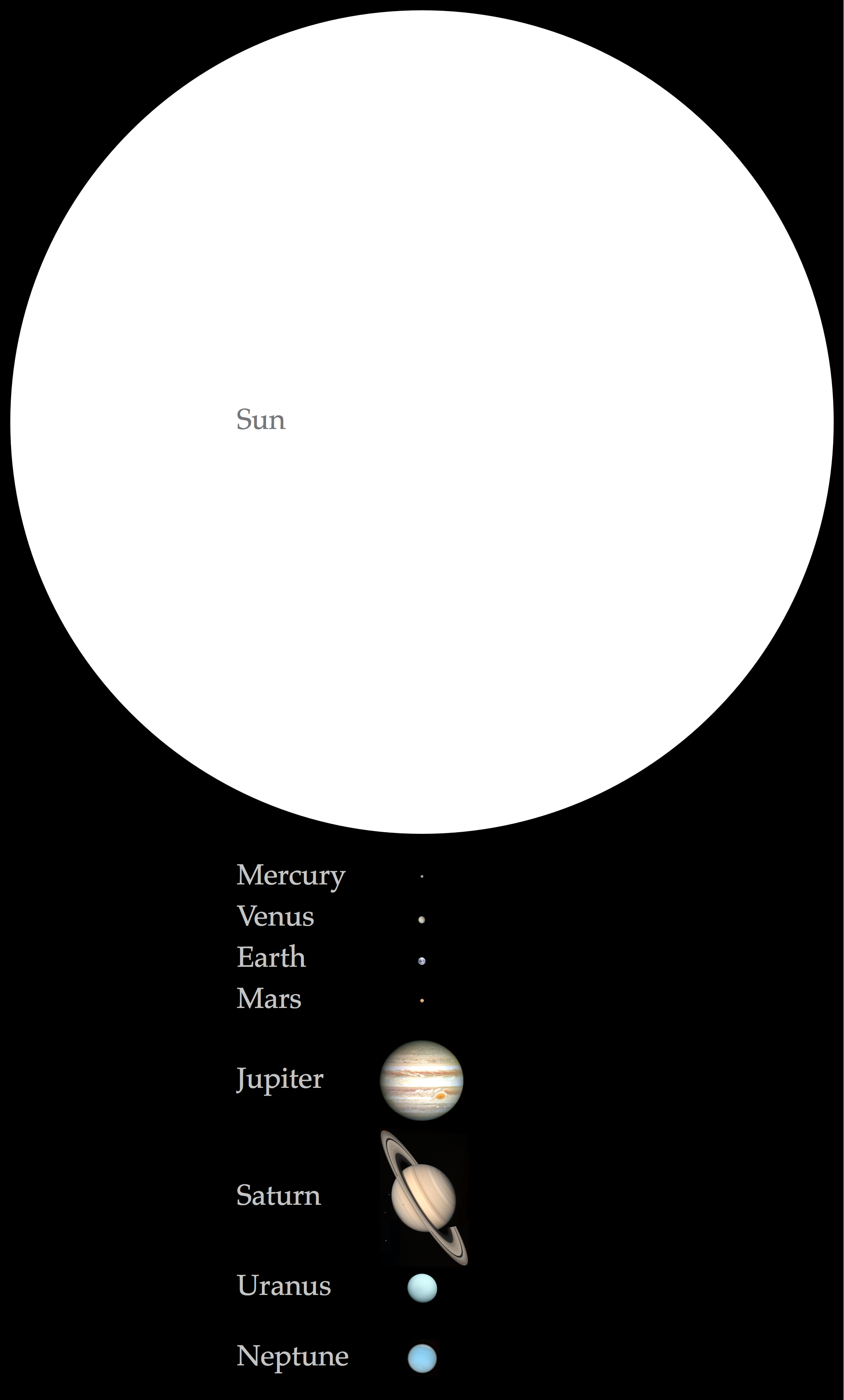Proportionally sized Solar System objects in natural colors

Figure 1: Proportionally sized planets and the Sun in natural colors. Zoom in to view details.
Seeing planets in context
On Figure 1 I hoped to illustrate the differences in sizes between the planets and the Sun in order to visualize the magnitude of our cosmic neighborhood. We know that planet Earth is approximately 109 times smaller than the Sun. It is surprising to actually see how small our planet is when it is placed next to the “gas giants” Jupiter and Saturn. When looking at this picture I try to imagine the size of my city, my house or my own body and realize how insignificant they are at the planetary scale.
If planet Earth was a hamster …
Looking at different sizes of the Solar System objects I could not help but think of common sense analogies.
-
If planet Earth was a hamster (5.5 cm in length) the Sun would be as big as an African bush elephant (6 m in length) and Jupiter would be a koala (60 cm in length) chewing eucalyptus leaves.
-
If you took all the land area from Earth and transfer it to Mars it would cover Mars almost entirely. There would be no room for the Earth oceans on Mars so don’t expect to have long cruises there in the future. Surprising fact about Mars is that its surface area (145 million km²) is almost equal to the land area of Earth (149 million km²).
-
If the Earth was the size of the Sun a flight from New York to London would take one month. That would mean eating a hundred of airplane meals, unfortunately. The Sun is 109 times larger than the Earth, so the 7 hour flight would take 7 * 109 = 763 hours. Here I assume that distances on Earth would grow proportionally but the speed of a commercial airplane would stay the same.
But the image is still not quite right
The relative sizes of the planets and the Sun shown on Figure 1 are approximately correct but some other physical properties are imprecise.
1) Distances between planets
The image above shows the planets separated by equal intervals. In reality, of course, those distances are unequal. I could not draw the image with both planet sizes and distances in scale because the distances between planets are many times greater than their sizes. For example, the distance between the Sun and Mercury equals roughly to 83 Sun diameters. Or we can imagine it this way: it would take 83 Suns to fill the distance between the Sun and Mercury. A realistic image of the Solar System would be so big that you would need to scroll the screen 100 times to get from the Sun to its first planet Mercury. It would take another 150 screens to reach the Earth. Although such image would be more realistic I doubt anyone could find it useful.
2) Colors
The image shows the planets and the Sun in real colors. It means that the objects look similar to what an astronaut would see when observing them from space. For example, if you were on a space ship you would perceive the Sun as almost white, while it looks yellow or orange from Earth due to the effect of Rayleigh scattering of sunlight in the atmosphere.
3) Brightness
While planet colors shown on Figure 1 are approximately correct their brightness is not. This is because the amount of light from a star that reaches a fixed area of space is inversely proportional to the square of the distance from that star. This physical fact is described by the following equation for the surface area of the sphere, where r is the radius of the sphere.
A = 4πr²
It can be seen from this equation that the farther away the planet is from the Sun the less light it receives. For example, Uranus is approximately 19 times farther away from the Sun than the Earth. Consequently, when compared with Earth a square meter on Uranus receives 361 times less light. As a result, distant planets like Uranus and Neptune should appear darker than they are on Figure 1.
4) Positions of the planets
Needless to say, the planets of the Solar System do not magically align to form a straight line shown on the image. Perfect alignment of the planets within a degree is such an improbable event that it would unlikely to happen in the future during the lifespan of the Solar System.
Data for the sizes of the Sun and its planets
To create Figure 1 I used the data for the sizes of the Sun and its planets shown in Table 1. The size of each object is expressed as the mean radius in kilometers. The mean radius of an astronomical object is the average distance from its surface to its center. In addition, the table shows the sizes relative to the Sun.
| Object name | Radius (km) | Relative to the Sun |
|---|---|---|
| Sun | 696,342 | 1.000000 |
| Mercury | 2,440 | 0.003504 |
| Venus | 6,052 | 0.008691 |
| Earth | 6,371 | 0.009149 |
| Mars | 3,390 | 0.004868 |
| Jupiter | 69,911 | 0.100398 |
| Saturn | 58,232 | 0.083626 |
| Uranus | 25,362 | 0.036422 |
| Neptune | 24,622 | 0.035359 |
Table 1: Mean radii of the Sun and its planets.
Photo sources
- Mercury: NASA, Messanger, source
- Venus: NASA, Mattias Malmer, Mariner 10, source.
- Earth: NASA, Apollo 17, source.
- Mars: NASA, Hubble Space Telescope, source.
- Jupiter: NASA, ESA, and A. Simon (Goddard Space Flight Center), Hubble Space Telescope, source.
- Saturn: NASA, Voyager 2, source.
- Uranus: NASA, Voyager 2, source.
- Neptune: NASA, Hubble Space Telescope, source.
Sources of the size data
- Sun: Emilio, M.; Kuhn, J. R.; Bush, R. I.; Scholl, I. F. (2012). “Measuring the Solar Radius from Space during the 2003 and 2006 Mercury Transits”. The Astrophysical Journal, Volume 750, Issue 2, article id. 135, 8 pp. (2012). Links: arXiv:1203.4898v1, 2012ApJ…750..135E, doi:10.1088/0004-637X/750/2/135..
- Mercury, Venus, Mars, Jupiter, Saturn, Uranus and Neptune: Seidelmann, P. Kenneth; Archinal, Brent A.; A’Hearn, Michael F.; et al. (2007). “Report of the IAU/IAG Working Group on cartographic coordinates and rotational elements: 2006”. Celestial Mechanics and Dynamical Astronomy, Volume 98, Issue 3, pp.155-180. Links: 2007CeMDA..98..155S, doi:10.1007/s10569-007-9072-y.
- Earth: Various (2000). David R. Lide, ed. Handbook of Chemistry and Physics (81st ed.). CRC Press. ISBN 0-8493-0481-4.
